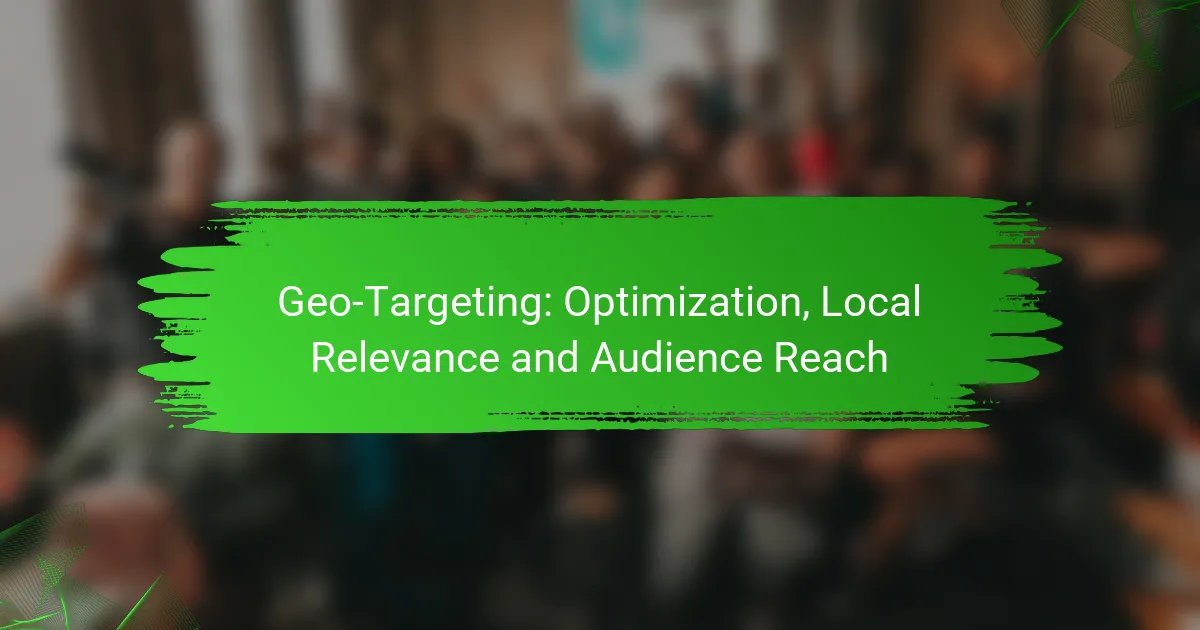Geo-targeting is a powerful strategy that enables marketers in New Zealand to deliver customized advertisements based on the geographic location of their audience. By employing location-specific tactics, such as local keywords and geo-fencing, businesses can enhance ad relevance and engagement, ultimately leading to improved campaign performance and audience reach.

How does geo-targeting enhance display advertising in New Zealand?
Geo-targeting enhances display advertising in New Zealand by allowing marketers to deliver tailored ads based on the geographic location of their audience. This localized approach increases the relevance of advertisements, making them more appealing to consumers and improving overall campaign effectiveness.
Increased local relevance
Geo-targeting ensures that ads resonate with local audiences by incorporating regional preferences and cultural nuances. For instance, a restaurant in Auckland can promote its special menu items that cater to local tastes, while a retailer in Wellington can highlight seasonal sales relevant to that area.
By focusing on specific locations, businesses can create more personalized messages that reflect the interests and needs of the community, leading to a stronger connection with potential customers.
Improved audience engagement
When ads are geo-targeted, they are more likely to capture the attention of the intended audience. This is because consumers are more responsive to promotions and information that pertain to their immediate environment. For example, a local event advertisement will engage residents more effectively than a generic national campaign.
Using geo-targeting, advertisers can also experiment with different messaging strategies for various regions, enhancing engagement through tailored content that speaks directly to local interests.
Higher conversion rates
Geo-targeting can lead to higher conversion rates as it aligns advertising efforts with the specific needs of local consumers. By presenting relevant offers, such as discounts for nearby stores, businesses can encourage immediate action from potential customers.
Additionally, studies suggest that localized ads can improve conversion rates by significant margins, often ranging from 10% to 30%, depending on the industry and execution. Advertisers should continuously analyze performance metrics to refine their geo-targeting strategies for optimal results.

What are the best practices for geo-targeting in New Zealand?
Effective geo-targeting in New Zealand involves using location-specific strategies to enhance relevance and audience engagement. By focusing on local keywords, leveraging location-based data, and implementing geo-fencing, businesses can significantly improve their marketing outcomes.
Utilizing local keywords
Incorporating local keywords into your content is essential for effective geo-targeting. This means using terms that reflect the local vernacular, landmarks, and cultural references relevant to New Zealand audiences. For example, instead of just “coffee shop,” use “café in Wellington” to attract local search traffic.
Consider using tools like Google Keyword Planner to identify popular local search terms. Aim to include these keywords naturally in your website content, meta descriptions, and social media posts to enhance visibility in local searches.
Leveraging location-based data
Location-based data can provide insights into customer behavior and preferences, allowing for more tailored marketing efforts. Utilize analytics tools to track where your visitors are coming from and adjust your strategies accordingly. For instance, if data shows high traffic from Auckland, consider creating targeted promotions for that region.
Additionally, consider using customer relationship management (CRM) systems that integrate location data to segment your audience effectively. This can help in crafting personalized messages that resonate with local consumers.
Implementing geo-fencing strategies
Geo-fencing involves creating virtual boundaries around specific locations to trigger marketing messages when potential customers enter these areas. This can be particularly effective for businesses with physical locations, such as retail stores or restaurants in New Zealand.
To implement geo-fencing, use mobile advertising platforms that allow you to set up location-based alerts. For example, a café could send a discount offer to customers who enter a certain radius around their location. Ensure compliance with local privacy regulations when collecting and using location data.

What tools can optimize geo-targeting efforts?
Several tools can enhance geo-targeting efforts by allowing businesses to reach specific audiences based on their location. Utilizing these tools effectively can improve ad performance and increase local relevance.
Google Ads location targeting
Google Ads offers robust location targeting options that enable advertisers to reach users in specific geographic areas. You can target by country, region, city, or even a radius around a specific address, making it easy to tailor your campaigns to local audiences.
To optimize your campaigns, consider using location bid adjustments. This feature allows you to increase or decrease bids based on the performance of specific locations, ensuring you allocate your budget effectively. Regularly review location performance reports to refine your targeting strategy.
Facebook Ads geo-targeting
Facebook Ads provides geo-targeting capabilities that let you reach users based on their current location, as well as their interests and behaviors. You can define your audience by city, state, or even a specific radius from a location, which is particularly useful for local businesses.
Utilize Facebook’s audience insights to understand the demographics and preferences of users in your target area. This can help you create more relevant ad content that resonates with local audiences. Be cautious of over-targeting, as it may limit your reach unnecessarily.
SEMrush local SEO tools
SEMrush offers a suite of local SEO tools designed to enhance your visibility in local search results. Features like the Position Tracking tool allow you to monitor your rankings for specific keywords in designated locations, ensuring you stay competitive.
Additionally, SEMrush provides tools for managing local listings and citations, which are crucial for improving local search rankings. Regularly audit your listings for accuracy and consistency across platforms to maximize your local SEO efforts. Consider leveraging the review management feature to enhance your online reputation in your target areas.

How can businesses measure the effectiveness of geo-targeting?
Businesses can measure the effectiveness of geo-targeting by analyzing local engagement metrics, conversion rates by location, and conducting A/B testing for local ads. These methods provide insights into how well targeted campaigns resonate with specific audiences in different geographic areas.
Tracking local engagement metrics
Tracking local engagement metrics involves monitoring interactions such as clicks, shares, and comments from users in targeted regions. Tools like Google Analytics can help businesses segment data by location, allowing them to see which areas are most responsive to their marketing efforts.
Common metrics to focus on include page views, average session duration, and bounce rates. For instance, a business may find that users in urban areas engage more with their content compared to rural locations, guiding future marketing strategies.
Analyzing conversion rates by location
Analyzing conversion rates by location helps businesses understand how effectively their geo-targeted campaigns drive sales or desired actions. By comparing conversion rates across different regions, companies can identify high-performing areas and those needing improvement.
For example, if a local restaurant sees a significantly higher conversion rate from ads targeting nearby neighborhoods compared to distant ones, they may choose to allocate more resources to local promotions. This analysis can also reveal trends, such as seasonal variations in consumer behavior based on location.
Utilizing A/B testing for local ads
Utilizing A/B testing for local ads allows businesses to experiment with different messaging, visuals, and offers tailored to specific regions. By running simultaneous campaigns with slight variations, companies can determine which approach resonates best with local audiences.
For effective A/B testing, ensure that the sample size is adequate for each location to yield statistically significant results. For instance, a retailer might test two different promotional messages in a city and measure which one leads to higher foot traffic or online sales.

What are the challenges of geo-targeting in New Zealand?
Geo-targeting in New Zealand faces several challenges, including strict data privacy regulations, the potential for inaccurate location data, and intense competition for local visibility. These factors can hinder effective audience reach and local relevance for businesses aiming to optimize their marketing strategies.
Data privacy regulations
New Zealand has stringent data privacy laws, primarily governed by the Privacy Act 2020. Businesses must ensure compliance when collecting and using location data, which can limit the scope of geo-targeting efforts. Non-compliance can lead to significant penalties, making it crucial for companies to understand and navigate these regulations effectively.
To mitigate risks, organizations should implement transparent data collection practices and obtain explicit consent from users. Regular audits of data handling processes can help maintain compliance and build customer trust.
Inaccurate location data
Inaccurate location data can severely impact the effectiveness of geo-targeting campaigns. Factors such as GPS inaccuracies, VPN usage, or outdated user information can lead to misdirected marketing efforts. This can result in wasted resources and missed opportunities to engage the intended audience.
To improve accuracy, businesses should utilize multiple data sources and regularly update their location databases. Employing geolocation technologies that verify user locations can enhance targeting precision and effectiveness.
Competition for local visibility
In New Zealand’s competitive market, gaining local visibility can be challenging for businesses. Many companies vie for the same audience, making it essential to stand out through effective geo-targeting strategies. Local SEO practices, such as optimizing Google My Business listings, can significantly enhance visibility.
Focusing on unique selling points and tailoring content to local preferences can help businesses differentiate themselves. Additionally, leveraging local partnerships and community engagement can further boost visibility and relevance in specific regions.










